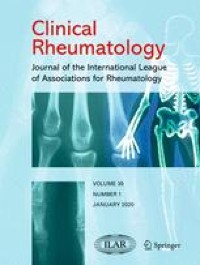|
ΩτοΡινοΛαρυγγολόγος Medicine by Alexandros G. Sfakianakis,Anapafseos 5 Agios Nikolaos 72100 Crete Greece,00302841026182,00306932607174,
Translate
Ετικέτες
Κυριακή 4 Απριλίου 2021
Heel fat pad involvement in rheumatoid arthritis: a review and case series
Εγγραφή σε:
Σχόλια ανάρτησης (Atom)
Αρχειοθήκη ιστολογίου
-
►
2023
(278)
- ► Φεβρουαρίου (139)
- ► Ιανουαρίου (139)
-
►
2022
(1962)
- ► Δεκεμβρίου (107)
- ► Σεπτεμβρίου (158)
- ► Φεβρουαρίου (165)
- ► Ιανουαρίου (163)
-
▼
2021
(3614)
- ► Δεκεμβρίου (152)
- ► Σεπτεμβρίου (271)
-
▼
Απριλίου
(326)
- ὁ δὲ ἡγεμὼν ἔφη· τί γὰρ κακὸν ἐποίησεν; οἱ δὲ περι...
- Bruxismo y su relación con otorrinolaringología: u...
- Síndrome de apnea obstructiva del sueño persistent...
- Evaluación electrofisiológica del procesamiento au...
- Dural Tears During Lumbar Spinal Endoscopy: Surgeo...
- A Study on Otorhinolaryngological Presentations in...
- Ileocecal Valve and Cecum Adenocarcinoma Metastati...
- Trust in physicians among patients with head and n...
- Transoral robotic surgery versus nonrobotic resect...
- Bilateral Puffy Orbits in a toddler: Therapeutic C...
- Donor- and recipient-site morbidity of vascularize...
- COVID-19 vaccines and cancer patients: State of th...
- Vaccination against COVID-19 in patients with soli...
- Rheumatic immune adverse events related to immune ...
- Effectiveness of physical activity interventions i...
- Bilateral Posterior Nasoseptal Flap - Double Breas...
- Olfactory and Gustatory Dysfunction in Covid-19: A...
- Geographic Variations in Healthcare Utilization an...
- Very‐Low Energy Monopolar Reduces Post‐Tonsillecto...
- Opening the Palatovaginal Canal to Maximize Anteri...
- Colorectal dimensions in the general population: i...
- Chronic administration of pharmacological doses of...
- Increasing prediction accuracy of pathogenic stagi...
- Die Behandlung von Schilddrüsenmalignomen aus HNO-...
- Dermatomyositis als paraneoplastisches Syndrom bei...
- Revision canal-wall down surgery: comparison of su...
- Homologación lingüística al idioma español, en pob...
- Valores referenciales de posturografía basada en N...
- Adherencia al uso de audífonos en adultos mayores ...
- Reflejo olivococlear contralateral y su relación c...
- Differentiated thyroid carcinoma in children: A re...
- Impact of thyroid cancer treatment on assisted rep...
- Bilateral juvenile nasopharyngeal angiofibroma: A ...
- Brain microstructural and metabolic alterations de...
- Dual mTORC1/mTORC2 inhibition as a Host-Directed T...
- In Vitro Activity of Oxazolidinone against Nontube...
- Multidrug Resistance Efflux Pumps in Acinetobacter...
- Luminore CopperTouch™ surface coating effectively ...
- Quinolin-(1H)-imines as a new chemotype against le...
- Melting the Eis: non-detection of kanamycin resist...
- Overcoming culture restriction for SARS-CoV-2 in h...
- External Evaluation of Two Pediatric Population Ph...
- Traumatic ischemic injury in a top of the basilar ...
- The frequency of cytomegalovirus non-ELR UL146 gen...
- Episodic headache with spontaneous hypothermia rev...
- Cancers, Vol. 13, Pages 2100: BLBP Is Both a Marke...
- Cancers, Vol. 13, Pages 2099: De-Escalation of The...
- Critical illness-related corticosteroid insufficie...
- Cancers, Vol. 13, Pages 2101: Emerging Lab-on-a-Ch...
- Correlation of Voice Hoarseness and Vocal Cord Pal...
- Web-Based Educational Intervention for Patients Wi...
- Melatonin for an obese child with MC4R gene varian...
- Minimally invasive treatment of forearm double fra...
- Prognostic nomograms for predicting overall surviv...
- Klebsiella pneumoniae infection secondary to spont...
- Three-dimensional-printed custom-made patellar end...
- Eltrombopag-related renal vein thromboembolism in ...
- Neoadjuvant chemoradiotherapy followed by laparosc...
- Cryptococcus infection with asymptomatic diffuse p...
- Endoscopic diagnosis of early-stage primary esopha...
- Triple administration of osimertinib followed by c...
- Current status of radical laparoscopy for treating...
- Anesthetic management of a child with double outle...
- Possible effect of blonanserin on gambling disorde...
- Combined immune checkpoint inhibitors of CTLA4 and...
- Cerebellar artery infarction with sudden hearing l...
- Cholangiojejunostomy for multiple biliary ducts in...
- Extraosseous spinal epidural plasmocytoma associat...
- Surgical therapy for hemangioma of the azygos vein...
- Early colonoscopy and urgent contrast enhanced com...
- Calcium pyrophosphate deposition disease of the te...
- Gastrointestinal-type chemotherapy prolongs surviv...
- Rare histological subtype of invasive micropapilla...
- Differences in dietary habits of people with vs wi...
- Contrast-enhanced ultrasound using SonoVue mixed w...
- Nemaline myopathy with dilated cardiomyopathy and ...
- Stigmatic Impact of COVID-19 Pandemic on Head & Ne...
- A Rare Case Report of Unilateral Maxillary Mass fr...
- Coblation cryptolysis method in treatment of tonsi...
- Measuring Tracheotomy Risk in Patients With COVID-19
- Epiglottic Mass in an Infant
- Total Thyroidectomy vs Lobectomy for Management of...
- Safety of Percutaneous vs Open Tracheostomy on Int...
- A Study on Acute Membranous Tonsillitis, Its Diffe...
- Reconstructive Management of Gunshot Wounds to the...
- Methylomic analysis identifies C11orf87 as a novel...
- Nasal Septal Swell Body: A Distinctive Structure i...
- Olfactory Cleft Opacification in COVID-19 Related ...
- Laryngeal Sarcoidosis
- Paeoniflorin suppresses allergic and inflammatory ...
- Microcirculatory disturbance in acute liver injury
- Downregulation of miR-588 is associated with tumor...
- Dl-butylphthalide inhibits rotenone-induced oxidat...
- Interferon-τ regulates the expression and function...
- Intra-articular injections of platelet-rich plasma...
- Anticancer activity of 23,24-dihydrocucurbitacin B...
- Role of NGF and its receptors in wound healing (Re...
- Role of Notch, IL-1 and leptin expression in color...
- Comparison of anti-inflammatory effects of Mecasin...
- A minimum 8-year follow-up comparative study of de...
- ► Φεβρουαρίου (64)
- ► Ιανουαρίου (357)
-
►
2020
(3279)
- ► Δεκεμβρίου (396)
- ► Σεπτεμβρίου (157)
- ► Φεβρουαρίου (382)
- ► Ιανουαρίου (84)
-
►
2019
(11718)
- ► Δεκεμβρίου (265)
- ► Σεπτεμβρίου (545)
- ► Φεβρουαρίου (1143)
- ► Ιανουαρίου (744)
-
►
2017
(2)
- ► Φεβρουαρίου (1)
- ► Ιανουαρίου (1)



Δεν υπάρχουν σχόλια:
Δημοσίευση σχολίου